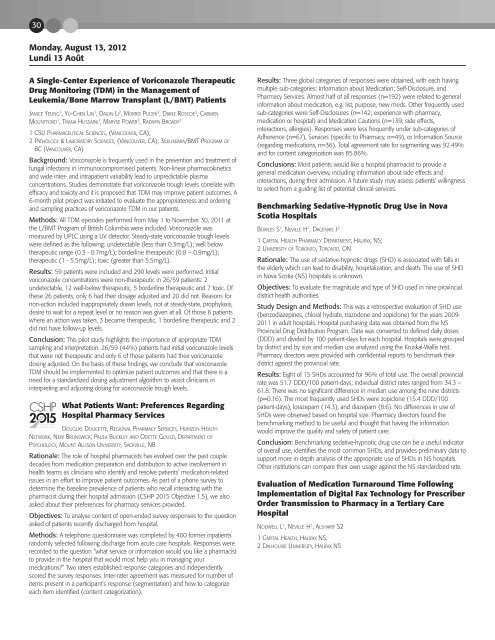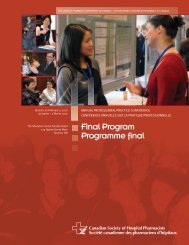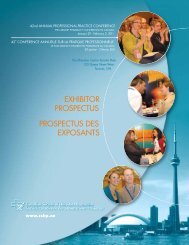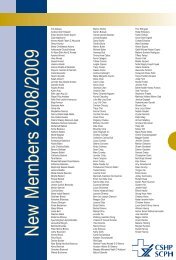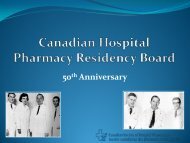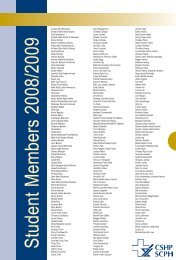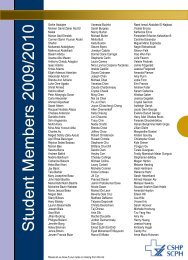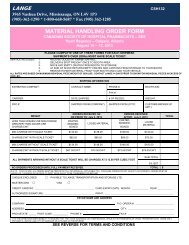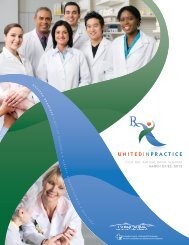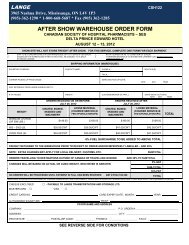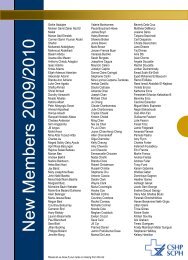Final Program - Canadian Society of Hospital Pharmacists
Final Program - Canadian Society of Hospital Pharmacists
Final Program - Canadian Society of Hospital Pharmacists
You also want an ePaper? Increase the reach of your titles
YUMPU automatically turns print PDFs into web optimized ePapers that Google loves.
30<br />
Monday, August 13, 2012<br />
Lundi 13 Août<br />
A Single-Center Experience <strong>of</strong> Voriconazole Therapeutic<br />
Drug Monitoring (TDM) in the Management <strong>of</strong><br />
Leukemia/Bone Marrow Transplant (L/BMT) Patients<br />
JANICE YEUNG 1 , YU-CHEN LIN 1 , DAILIN LI 2 , MORRIS PUDEK 2 , DIANE ROSCOE 2 , CARMEN<br />
MOUNTFORD 1 , TRANA HUSSAINI 1 , MARYSE POWER 3 , RAEWYN BROADY 3<br />
1 CSU PHARMACEUTICAL SCIENCES, (VANCOUVER, CA);<br />
2 PATHOLOGY & LABORATORY SCIENCES, (VANCOUVER, CA); 3LEUKEMIA/BMT PROGRAM OF<br />
BC (VANCOUVER, CA)<br />
Background: Voriconazole is frequently used in the prevention and treatment <strong>of</strong><br />
fungal infections in immunocompromised patients. Non-linear pharmacokinetics<br />
and wide inter- and intrapatient variability lead to unpredictable plasma<br />
concentrations. Studies demonstrate that voriconazole trough levels correlate with<br />
efficacy and toxicity and it is proposed that TDM may improve patient outcomes. A<br />
6-month pilot project was initiated to evaluate the appropriateness and ordering<br />
and sampling practices <strong>of</strong> voriconazole TDM in our patients.<br />
Methods: All TDM episodes performed from May 1 to November 30, 2011 at<br />
the L/BMT <strong>Program</strong> <strong>of</strong> British Columbia were included. Voriconazole was<br />
measured by UPLC using a UV detector. Steady-state voriconazole trough levels<br />
were defined as the following: undetectable (less than 0.3mg/L); well below<br />
therapeutic range (0.3 - 0.7mg/L); borderline therapeutic (0.8 – 0.9mg/L);<br />
therapeutic (1 - 5.5mg/L); toxic (greater than 5.5mg/L).<br />
Results: 59 patients were included and 290 levels were performed. Initial<br />
voriconazole concentrations were non-therapeutic in 26/59 patients: 2<br />
undetectable, 12 well-below therapeutic, 5 borderline therapeutic and 7 toxic. Of<br />
these 26 patients, only 6 had their dosage adjusted and 20 did not. Reasons for<br />
non-action included inappropriately drawn levels, not at steady-state, prophylaxis,<br />
desire to wait for a repeat level or no reason was given at all. Of those 6 patients<br />
where an action was taken, 3 became therapeutic, 1 borderline therapeutic and 2<br />
did not have follow-up levels.<br />
Conclusion: This pilot study highlights the importance <strong>of</strong> appropriate TDM<br />
sampling and interpretation. 26/59 (44%) patients had initial voriconazole levels<br />
that were not therapeutic and only 6 <strong>of</strong> those patients had their voriconazole<br />
dosing adjusted. On the basis <strong>of</strong> these findings, we conclude that voriconazole<br />
TDM should be implemented to optimize patient outcomes and that there is a<br />
need for a standardized dosing adjustment algorithm to assist clinicians in<br />
interpreting and adjusting dosing for voriconazole trough levels.<br />
2 CSHP<br />
Targeting Excellence<br />
What Patients Want: Preferences Regarding<br />
<strong>Hospital</strong> Pharmacy Services<br />
in Pharmacy Practice<br />
DOUGLAS DOUCETTE, REGIONAL PHARMACY SERVICES, HORIZON HEALTH<br />
NETWORK, NEW BRUNSWICK; PAULA BUCKLEY AND ODETTE GOULD, DEPARTMENT OF<br />
PSYCHOLOGY, MOUNT ALLISON UNIVERSITY, SACKVILLE, NB<br />
Rationale: The role <strong>of</strong> hospital pharmacists has evolved over the past couple<br />
decades from medication preparation and distribution to active involvement in<br />
health teams as clinicians who identify and resolve patients’ medication-related<br />
issues in an effort to improve patient outcomes. As part <strong>of</strong> a phone survey to<br />
determine the baseline prevalence <strong>of</strong> patients who recall interacting with the<br />
pharmacist during their hospital admission (CSHP 2015 Objective 1.5), we also<br />
asked about their preferences for pharmacy services provided.<br />
Objectives: To analyse content <strong>of</strong> open-ended survey responses to the question<br />
asked <strong>of</strong> patients recently discharged from hospital.<br />
Methods: A telephone questionnaire was completed by 400 former inpatients<br />
randomly selected following discharge from acute care hospitals. Responses were<br />
recorded to the question “what service or information would you like a pharmacist<br />
to provide in the hospital that would most help you in managing your<br />
medications?” Two raters established response categories and independently<br />
scored the survey responses. Inter-rater agreement was measured for number <strong>of</strong><br />
items present in a participant’s response (segmentation) and how to categorize<br />
each item identified (content categorization).<br />
Results: Three global categories <strong>of</strong> responses were obtained, with each having<br />
multiple sub-categories: Information about Medication; Self-Disclosure, and<br />
Pharmacy Services. Almost half <strong>of</strong> all responses (n=192) were related to general<br />
information about medication, e.g. list, purpose, new meds. Other frequently used<br />
sub-categories were Self-Disclosures (n=142; experience with pharmacy,<br />
medication or hospital) and Medication Cautions (n=139; side effects,<br />
interactions, allergies). Responses were less frequently under sub-categories <strong>of</strong><br />
Adherence (n=67), Services (specific to Pharmacy, n=49), or Information Source<br />
(regarding medications, n=36). Total agreement rate for segmenting was 92.49%<br />
and for content categorization was 85.86%.<br />
Conclusions: Most patients would like a hospital pharmacist to provide a<br />
general medication overview, including information about side effects and<br />
interactions, during their admission. A future study may assess patients’ willingness<br />
to select from a guiding list <strong>of</strong> potential clinical services.<br />
Benchmarking Sedative-Hypnotic Drug Use in Nova<br />
Scotia <strong>Hospital</strong>s<br />
BOWLES S 1 , NEVILLE H 1 , DAGENAIS J 2<br />
1 CAPITAL HEALTH PHARMACY DEPARTMENT, HALIFAX, NS;<br />
2 UNIVERSITY OF TORONTO, TORONTO, ON<br />
Rationale: The use <strong>of</strong> sedative-hypnotic drugs (SHD) is associated with falls in<br />
the elderly which can lead to disability, hospitalization, and death. The use <strong>of</strong> SHD<br />
in Nova Scotia (NS) hospitals is unknown.<br />
Objectives: To evaluate the magnitude and type <strong>of</strong> SHD used in nine provincial<br />
district health authorities.<br />
Study Design and Methods: This was a retrospective evaluation <strong>of</strong> SHD use<br />
(benzodiazepines, chloral hydrate, trazodone and zopiclone) for the years 2009-<br />
2011 in adult hospitals. <strong>Hospital</strong> purchasing data was obtained from the NS<br />
Provincial Drug Distribution <strong>Program</strong>. Data was converted to defined daily doses<br />
(DDD) and divided by 100 patient-days for each hospital. <strong>Hospital</strong>s were grouped<br />
by district and by size and median use analyzed using the Kruskal-Wallis test.<br />
Pharmacy directors were provided with confidential reports to benchmark their<br />
district against the provincial rate.<br />
Results: Eight <strong>of</strong> 15 SHDs accounted for 96% <strong>of</strong> total use. The overall provincial<br />
rate was 51.7 DDD/100 patient-days; individual district rates ranged from 34.3 –<br />
61.8. There was no significant difference in median use among the nine districts<br />
(p=0.16). The most frequently used SHDs were zopiclone (15.4 DDD/100<br />
patient-days), lorazepam (14.3), and diazepam (8.6). No differences in use <strong>of</strong><br />
SHDs were observed based on hospital size. Pharmacy directors found the<br />
benchmarking method to be useful and thought that having the information<br />
would improve the quality and safety <strong>of</strong> patient care.<br />
Conclusion: Benchmarking sedative-hypnotic drug use can be a useful indicator<br />
<strong>of</strong> overall use, identifies the most common SHDs, and provides preliminary data to<br />
support more in-depth analysis <strong>of</strong> the appropriate use <strong>of</strong> SHDs in NS hospitals.<br />
Other institutions can compare their own usage against the NS standardized rate.<br />
Evaluation <strong>of</strong> Medication Turnaround Time Following<br />
Implementation <strong>of</strong> Digital Fax Technology for Prescriber<br />
Order Transmission to Pharmacy in a Tertiary Care<br />
<strong>Hospital</strong><br />
NODWELL L 1 , NEVILLE H 1 , ALSHARIF S2<br />
1 CAPITAL HEALTH, HALIFAX NS;<br />
2 DALHOUSIE UNIVERSITY, HALIFAX NS


